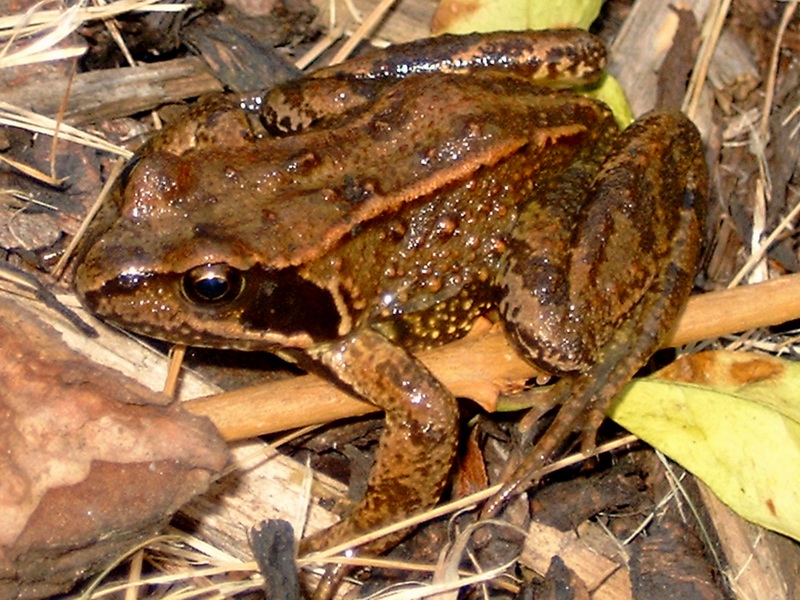ERROR : Server Busy(-1105)
ERROR : Server Busy(-1105)
Common Frog (Rana temporaria) - Wiki
Common Frog
From Wikipedia, the free encyclopedia
[Photo] Common Frog, Rana temporaria Linnaeus, 1758 - also known as Grass Frog, European Common Frog, European Common Brown Frog. This one (female) was photographed in a garden in Derbyshire in September 2004 by Bill and Sam Lionheart
The Common Frog, Rana temporaria also known as the European Common Frog or European Common Brown Frog is found throughout much of Europe as far north as the Arctic Circle and as far east as the Urals, except for most of Iberia, southern Italy, and the southern Balkans. The furthest west it can be found is Ireland, where it was introduced.
Appearance
Adult Common Frogs have a body length of between six and nine centimetres and their backs and flanks vary in colour, with olive green grey-brown, brown, olive-brown, grey, yellowish or rufous possible. However, Common Frogs are known to be able to lighten and darken their skin in order to match their surroundings. It is also not unknown for more unusual colouration- both black and red individuals have been found in Scotland, and Common Frogs have been known to turn blue in the mating season. Additionally, albino Common Frogs have been found with yellow skin and red eyes.
Common Frogs' flanks, limbs and backs are covered with irregular dark blotches and they usually sport a chevron-shaped spot on the back of their neck. Unlike other amphibians, Common Frogs generally lack a middorsal band, and when they have one, it is comparatively faint. The frogs' underbellies are white or yellow (occasionally more orange in females) and can be speckled with brown or orange.
Common Frogs have relatively short hind legs and possess webbed feet. Their eyes are brown with transparent horizontal pupils, and they have transparent inner eyelids to protect their eyes while underwater, as well as a 'mask' which covers their eyes and eardrums.
Males are distinguishable from females due to hard swellings (called nuptial pads) on their first finger. These are used for gripping females during mating. Also, during the mating season, males' throats often turn bluish. Males also possess paired vocal sacs, which the females lack. A final differentiation can be the colour- during the mating season, males are generally light and greyish in colour, where as the female is browner, or even red.
Although sometimes confused with the Common Toad, with which it often shares its habitat, the Common Frog is distinct in that it is larger, as well as hopping, as opposed to the toad's habit of walking. Additionally, Common Frogs have a sharper snout, and smooth skin, compared to the toad's more warty skin. Finally, toads lack dark patches behind the eye often seen on Common Frogs.
Distribution
The Common Frog is found throughout much of Europe as far north as the Arctic Circle and as far east as the Urals, except for most of Iberia, southern Italy, and the southern Balkans. A full list of the countries in which the Common Frog can be found is Albania, Andorra, Austria, Belarus, Belgium, Bulgaria, Croatia, Czech Republic, Denmark, Finland, France, Germany, Greece, Hungary, Ireland, Italy, Liechtenstein, Luxembourg, Republic of Macedonia, Netherlands, Norway, Poland, Romania, San Marino, Serbia and Montenegro, Slovakia, Slovenia, Spain, Sweden, Switzerland and the United Kingdom. The Common Frog can also be found in Ireland; and is the only frog found there. However it is not a native species, and was introduced to the country; a date or reason for which is not known. Other areas which the Common Frog has been introduced to include the Isle of Lewis, the Shetland Islands and the Orkney Islands.
Diet
Although not feeding throughout the breeding season, adult Common Frogs will feed on any invertebrate of a suitable size. Favourites include insects, (especially flies) snails, slugs and worms. The frogs hunt catch these animals by catching them on their long, sticky tongues. The diets of Common Frogs change significantly throughout their lives; whereas the oldest frogs will feed only on land, younger frogs will also feed in the water. Tadpoles are mostly herbivores, feeding on algae, detritus and some plants, although will also eat other animals in small amounts.
Habitat and habits
Common frogs are active almost all of the year, only hibernating when it gets very cold and the water and earth are consistently frozen. In the British Isles, common frogs typically hibernate from late October to January. They will re-emerge as early as February if conditions are favourable, and migrate to bodies of water such as garden ponds. Where conditions are harsher, such as in the Alps, they emerge as late as early June. Common frogs hibernate in running waters, muddy burrows and can hibernate in layers of decaying leaves and mud at the bottom of ponds. The fact that they can breathe through their skins allows them to stay underwater for much longer periods of time when they are hibernating.
Breeding
Common frogs breed in shallow, still, fresh water such as ponds, with breeding commencing in March. The adults congregate in the ponds, where the males compete for females. The courtship ritual involves croaking, and a successful male grasps the female under the forelegs. During the mating season the males can be recognised by a darkened swelling, the nuptial pad on their 'thumbs'. The females, which are generally larger than the males, lay up to 4000 eggs which float in large clusters.
http://en.wikipedia.org/wiki/Common_Frog
| The text in this page is based on the copyrighted Wikipedia article shown in above URL. It is used under the GNU Free Documentation License. You may redistribute it, verbatim or modified, providing that you comply with the terms of the GFDL. |
|

